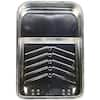Be aware that a dune buggy is shortened a different amount than a Speedster and Jeff will have to know the Speedster dimensions (From your CMC manual)
Front and rear disk brake conversion (which to use depends on the body style - classic side or wide body)
Decide whether you want 2” drop front spindles or stock height
Decide whether to use “Avis” style height adjusters or the bolt-style and on one front torsion bar or both.
Consider adding adjustable rear spring plates to help fine-tuning rear ride height and balance.
If you are tall (6’ or taller) now is the time to consider whether you need to lower the seats a couple of inches in the pan. Search on here for lowered seats.
You can spray the pan with truck bed liner as part of the rebuild process to make it pretty and durable.
Be aware that CMC bodies aren’t true and you’ll have to mess with it, especially at the rear, to get it even left/right on the pan so that the tires are equi-spaced between the rear wheel well lips. Lots of patience here will pay off in the long run. Make sure it’s true before final assembly and sealing body to pan.
CMC bodies also seem to droop starting right behind the doors. This causes the vertical seam between the rear of the door and the body to get wider as it goes up. You can’t see this until the body is mounted. The cure is to drill out the rivets holding the body’s inner wheel well wall to the body frame, gently/slowly jack up the rear corners of the body, and when the door rear seam is evenly spaced top to bottom, re-bolt the body to the frame. Search on here for CMC body droop fix or something like that.
Make sure you find the front body support. It mounts to the top of the front beam and supports the body just in front of the gas tank. Super important. It prevents spider-web cracks between the headlights and the frunk.
Don’t get too excited over the access to the shift rod coupler. Most of the cover is easily accessible and you may or may not need to cut a small (6” wide by 2”-3” deep) piece out of the shelf behind the seats for more access - I never needed to cut the body for more clearance. You’ll know once the body is on and then cutting a piece out isn’t a big deal, anyway.
Consider cutting an inspection port in the passenger side of the tunnel opposite the pedal cluster. This allows access to the clutch cable inside as well as the tube and its bracket that the cable slides through. That tube sometimes breaks the front weld right behind the pedal cluster and the only way to fix it is to open a port on the tunnel. Some on here my feel that this weakens the central structure but I have a port and have not noticed any weakness since opening it up.
Also consider getting a clutch pedal shaft with a bearing conversion on the cable end - They work really well (I have one).
Don’t bother setting the ride height until the car is assembled with everything in it and THEN set the ride height. It’s a pain to set ride height and balance right. Why do it more than once?
Research the under dash umbrella handle e-brake systems available and find the cable-lever-version one that is most effective - Not all are.
Decide whether you want front and/or rear anti-sway bars and the size you want and add them before the body goes on.
Don’t use gas shocks either end. Find a set of stock, oil-filled shocks.
The body style defines wheel width and dish so you can figure out what fits for wheels after the body is on.
I’m sure there is more, but this is a good start.
















